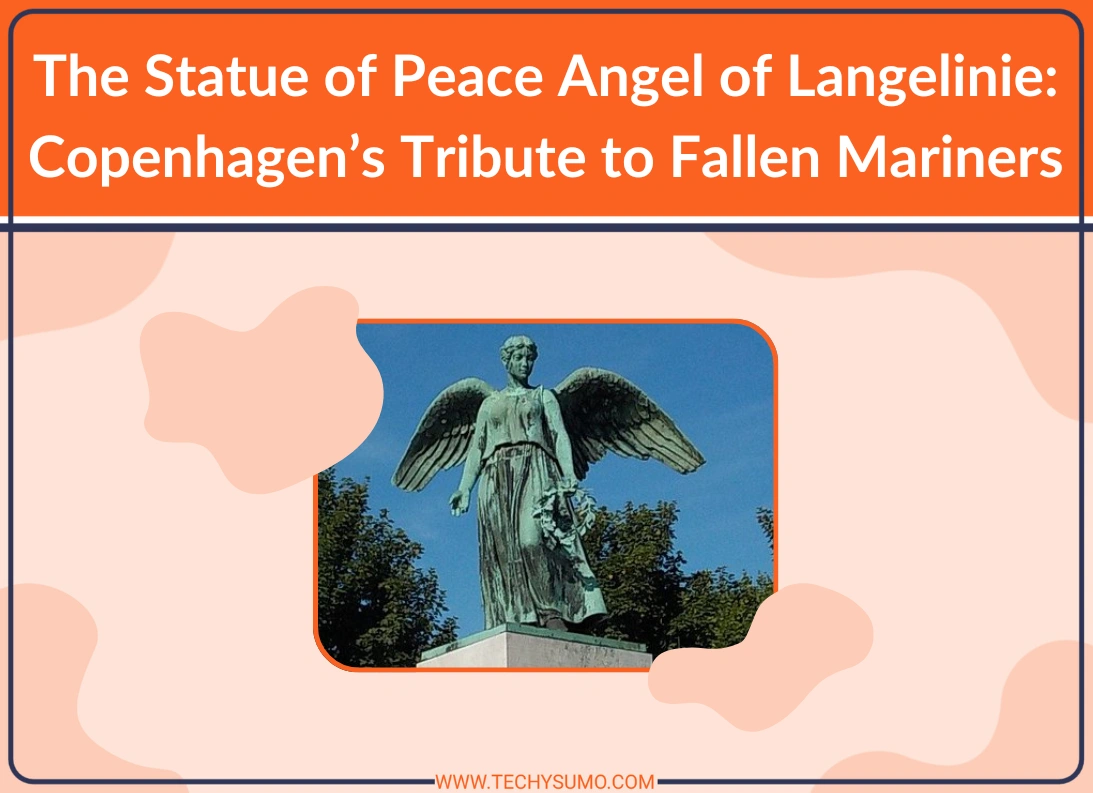Along Copenhagen’s picturesque Langelinie promenade, not far from the world-famous Little Mermaid, stands a monument that quietly commands respect and reflection: the Statue of Peace Angel of Langelinie. This elegant tribute honors Denmark’s merchant sailors who lost their lives during World War I.
The Statue of Peace is more than a work of art, it is a living reminder of sacrifice, resilience, and the enduring hope for peace.
Table of Contents
Honoring the Fallen: Origins of a Memorial
After World War I, Denmark faced the challenge of commemorating the hundreds of merchant seamen who perished at sea during the conflict. These civilians played a crucial role in keeping the nation’s lifelines open during the chaos of war.
Funding and Vision
In 1921, the Danish Steamship Owners’ Association decided to create a lasting memorial. The funds, originally set aside for a war accident insurance policy, were redirected to realize this vision. A committee was formed to oversee the project, emphasizing the need for a public symbol that would honor the fallen and promote the values of peace.
From Competition to Creation
To bring the Statue of Peace to life, a national competition was held. Sculptor Svend Rathsack and architect Ivar Bentsen were selected for their powerful and graceful design.
Also Read
The Monument’s Form
The monument was unveiled in 1928, quickly becoming one of Copenhagen’s most moving public memorials. The base, inspired by the prow of a ship, is carved from white marble and adorned with detailed reliefs depicting maritime life and the perils sailors faced during wartime.
Atop the plinth, the Statue of Peace takes the form of a bronze angel, wings outstretched, holding a laurel wreath high in her left hand. Her gaze is fixed over the water, as if eternally waiting for the safe return of lost sailors. The angel’s posture, both graceful and resolute, embodies the ideals of peace, victory, and remembrance.
Remembering the Names
The base of the Statue of Peace is engraved with the names of 648 Danish merchant seamen who lost their lives in World War I, ensuring their sacrifice is never forgotten.
A Nation Pays Tribute: The Unveiling
The unveiling ceremony was a significant event, attended by King Christian X, members of the royal family, government officials, and relatives of the fallen. A specially composed cantata and heartfelt speeches underscored the monument’s emotional and cultural impact. The Statue of Peace was immediately embraced as a symbol of national unity and hope for the future.
Enduring Through Time: Preservation
Over the decades, the Statue of Peace has weathered the elements, and by the early 21st century, restoration was necessary. The original limestone base was replaced with durable Italian marble in 2011, ensuring the monument’s message would endure for generations. Today, the Statue of Peace stands resplendent along the waterfront, its meaning undiminished by time.
A Place for Reflection: Visitors Today
Visitors to the Langelinie promenade often find themselves drawn to the Statue of Peace, pausing to read the inscriptions and contemplate the stories etched into its marble base. The angel’s commanding presence invites moments of quiet reflection on the cost of war and the value of peace.
The monument’s proximity to the Little Mermaid and the city’s cruise terminal makes it a natural stop for tourists, while locals appreciate its tranquil setting and the opportunity to honor Denmark’s maritime heritage.
More Than Stone and Bronze: A Living Memorial
The Statue of Peace Angel of Langelinie is not just a memorial it is a living part of Copenhagen’s cultural landscape. Each year, maritime organizations, veterans’ groups, and families of the fallen gather for ceremonies that keep the memory of the sailors alive. The angel serves as a silent guardian, watching over the harbor and inspiring all who see her to cherish peace and remember those who sacrificed for it.
Fostering Community and Identity
What makes the Statue of Peace especially compelling is how it continues to foster a sense of community and shared identity. School groups, tourists, and locals alike gather at the base of the monument for educational tours, commemorative events, or simple moments of quiet contemplation.
The angel’s outstretched wings seem to embrace all who visit, offering comfort and a gentle reminder of the cost of conflict. The reliefs and inscriptions encourage visitors to look beyond the surface, to imagine the lives of those commemorated and the families who waited for their return. In this way, the Statue of Peace serves not only as a memorial but as a catalyst for dialogue about peace, sacrifice, and the values that bind a nation together.
An Enduring Beacon
Nearly a century after its unveiling, the Statue of Peace continues to resonate with visitors from around the world. It stands as a testament to the bravery of Denmark’s merchant sailors and as a reminder that peace is precious and must be protected. The monument’s artistic beauty, historical significance, and emotional depth make it a must-see for anyone exploring Copenhagen.
Its enduring presence on Langelinie ensures that the lessons of history remain alive, relevant, and accessible to future generations.
An Invitation to Reflect
If you find yourself walking along the city’s waterfront, take a moment to visit the Statue of Peace Angel of Langelinie. It is a place where art, history, and memory converge, inviting everyone to reflect on the past and carry forward the hope for a more peaceful future.
The Statue of Peace remains a beacon an enduring symbol that peace is not merely the absence of war, but the presence of remembrance, vigilance, and shared humanity.






